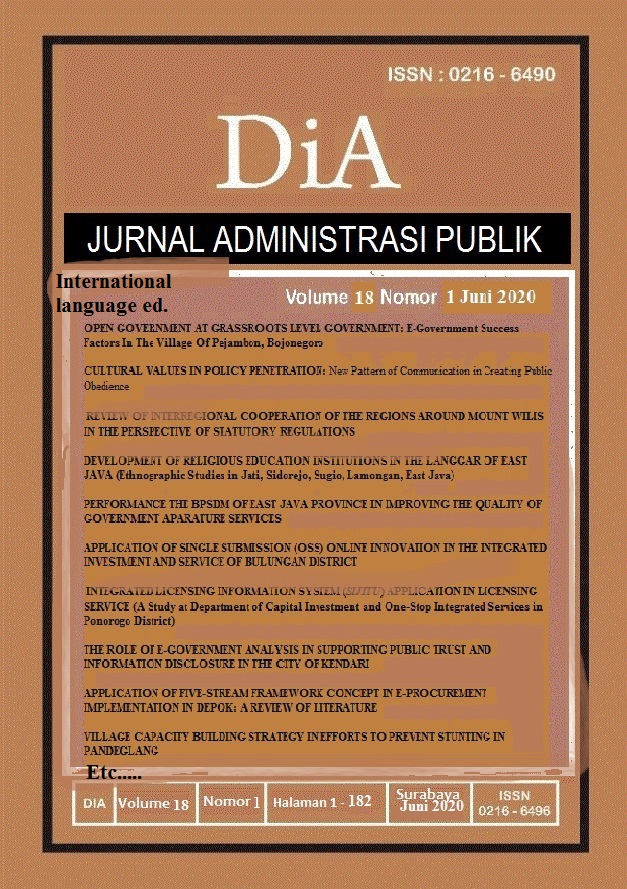HUMP-SHAPED RELATION IMPLEMENTATION IN EAST JAVA
DOI:
https://doi.org/10.30996/dia.v18i1.3485Keywords:
Degree of fiscal decentralization, economic growth, hump-shaped relationship, Fixed Effect ModelAbstract
This study aims to analyze the hump-shaped relation of regions in East Java Province. The proof of hump-shaped relation is seen from the influence of the degree of fiscal decentralization on economic growth. Fiscal decentralization analysis which is the ratio of regional original income and total regional expenditure, as well as using control variables consisting of government investment, and education which is implemented with reading and writing ability figures. The method used in this research is the econometrics approach. The model used in this study is the Fixed Effect Model with the Generalized Least Square method. The results of this study indicate that together the degree of decentralization, the degree of quadratic fiscal decentralization, government investment, the Gini ratio, the Gini squared ratio, and education significantly influence the regional economic growth in East Java Province. Partially the degree of decentralization, the degree of decentralized fiscal squared, government investment, the Gini ratio, the quadratic Gini ratio, and education also significantly affect economic growth, and show a hump-shape relationship, namely the degree of fiscal decentralization has a positive effect and quadratic fiscal decentralization hurts economic growth.
Downloads
References
Agarwal, RN (2012). Economic globalization, growth, and the environment: Testing of the Kuznets curve hypothesis environment for Malaysia. J. Bus. Finance. Affairs, 1 (2), 1–6.
Azazi, A. (2011). Is Soes Improved After Privatization ?: a Study on Financial Performance of Privatized Enterprises in Indonesia, 1994-2003? Journal of Business Economics and Entrepreneurship (JEBIK), 2 (1).
Azizi, M. (2018). The Implication Of General Allocation Fund, Special Allocation Fund, Profit Sharing Fund To Inequality The Gross Regional Domestic Product In South Sulawesi Province Period 2006-2014. Tasharruf: Journal of Economics and Business of Islam, 3 (1).
Basuki, AT, & Ingtinamah, J. (2017). Factors Affecting The Economic Growth In Special Regions Yogyakarta (Vector Error Correction Model Approach). UPN "Veteran" Yogyakarta Economic Bulletin, 15 (2), 155–166.
Central Statistics Agency of East Java Province. 2019. Economic Growth.
East Java Province Investment Board. 2019. Revitalization of Quarterly Investment III.
Gujarati, DN (2012). Basics of Econometrics, Translation. Salemba Empat. book 2, Issue 5. Jakarta
Handayani, A. (2016). The Validity of Indirect Evidence in the Cartel of Tires (Case Study of Verdict No. 08 / KPPU-I / 2014). UII Yogyakarta.
Kim, S., & Bae, K. Bin. (2019). The Effect of Decentralization on Economic Growth in Korea: The Role of the Implementation of Local Autonomy. Lex Localis-Journal of Local Self-Government, 17 (4).
Marlinda, M. (2019). The Influence Of Government Spending And Amount Of Labor And Inflation On Economic Growth And Labor Absorption In Malinau Regency. Journal of Economic Mulawarman (JIEM), 3 (1).
Octavianingrum, D. (2015). Analysis of the Effect of Investment, Labor, and Education Level on Economic Growth in the Special Region of Yogyakarta: Study of 5 Regencies / Cities. Economic Education Study Program, Faculty of Economics, Yogyakarta State University.
Soemantri, Y., & Setiawan, K. (2017). The Presence of Structural Breaks in the Indonesian Capital Market as a result of the Second Cabinet Reshuffle Announcement. Gadjah Mada University.
The Republic of Indonesia. (1999). Law of the Republic of Indonesia Number 22 of 1999 concerning Regional Government. Republic of Indonesia State Gazette Year 1999 Number 60. Secretariat of the Republic of Indonesia Cabinet. Jakarta.
--------------------------. (1999). Law of the Republic of Indonesia Number 25 of 1999 concerning Financial Balance between Central and Regional Governments. Republic of Indonesia State Gazette of 1999 Number 72. State Minister of State of the Republic of Indonesia. Jakarta
--------------------------. (2004). Law of the Republic of Indonesia Number 33 the Year 2004 concerning Financial Balance Between Central Government and Regional Government. Republic of Indonesia State Gazette Year 2004 Number 126. State Secretariat. Jakarta
--------------------------. (2014). Law of the Republic of Indonesia Number 23 of 2014 concerning Regional Government. Republic of Indonesia State Gazette of 2014 Number 244. Ministry of State Secretariat of the Republic of Indonesia. Jakarta
-------------------------. (2004). Law of the Republic of Indonesia Number 32 of 2004 concerning Regional Government. Republic of Indonesia State Gazette Year 2004 Number 125. State Secretariat. Jakarta
Winarni, AT (2017). Institutional Development Inter-Regional Cooperation In Central Java (Case Study Regionalization place of final processing waste). University Of 17 Augustus 1945.
Yang, Z. (2016). Tax reform, fiscal decentralization, and regional economic growth: New evidence from China. Economic Modeling, 59, 520-528.
Yu, J.-H., O'Reilly, SY, Wang, L., Griffin, WL, Zhou, M.-F., Zhang, M., & Shu, L. (2010). Components and episodic growth of Precambrian crust in the Malaysia Block, South China: evidence from U – Pb ages and Hf isotopes of zircons in Neoproterozoic sediments. Precambrian Research, 181 (1–4), 97–114.
Downloads
Published
How to Cite
Issue
Section
License
The DiA journal allows authors to retain the copyright of their papers without limitation. Authors may grant publishers non-exclusive publishing rights to publish articles. Granting first publishing rights to publishers also qualifies as unlimited copyright (because there are no restrictions imposed by publishers on author copyright).






